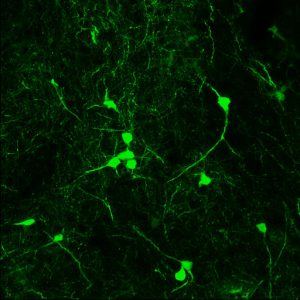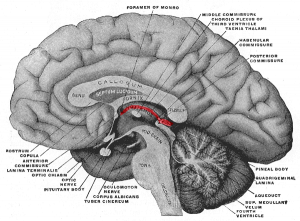Beyond the BNST

Strongly fluorescent P2rx7-expressing neurons in the bed nucleus of the stria terminalis in a mouse brain.
Transgenderism and transsexualism (TSTG) appear to be biological phenomena (see Born this Way). If this is so, then there ought to be observable structures and functions in the nervous system of TSTG that are different from non-TSTG individuals. We are in a much better position to search for such observables, now that MRI and functional MRI are common research tools.
The first, and perhaps the most talked about research study was conducted in the Netherlands with 7 MTF TS who donated their brains to science after death. The results of the study indicated that the bed nucleus of the stria terminalis (BNST) in these TS was intermediate in volume and number of neuron cells than male and female control groups. The stria terminalis (ST) is just a Latin name (stria means string) for a bundle of neurons that connects two important areas of the brain. The bed nucleus is home base for ST neurons and keeps the bundle alive and fed but it is also and important junction box. The ST connects the amygdala, an almond shape structure that controls emotion and the hypothalamus that controls emotional mechanisms. (When you are afraid, the hypothalamus is telling your heart to go faster.) The BNST also influences the dopamine mechanisms that are involved in pleasure and addiction. Most people have heard of dopamine in the context of cocaine and amphetamine because these two powerful drugs release it.
Perhaps it was because it was the first study to demonstrate the biological nature of TSTG, it immediately came under criticism from the usual quarters including J. Michael Bailey of The Man Who Would be Queen fame aligned with the Ray Blanchard crowd at the Centre for Addiction and Mental Health in Toronto. Bailey published a paper entitled What Many Transgender Activists Don’t Want You to Know: and Why You Should Know It Anyway in which he attacked the BNST study because it undermined Blanchard non-biological theories about the nature of TSTG. A gentle academic flame war erupted for a time between the Blanchard crowd and the investigators in the Netherlands. (The Blanchard supporters seem to have spent their anger on this study because they have not attacked subsequent findings.)
A nearby nucleus in the hypothalamus, the interstitial nucleus of the anterior hypothalamus number 3(INAH3), was also found by the Netherlands researchers to be intermediate in size between male and female controls for the same TS subjects used in the BNST study. In this study they also included one FTM whose INAH3 was similar in size to the male controls. This INAH3 appears to be involved in sexual reflexes in lower animals but little is known about it in humans. This time the controversy involved a previous study by Simon LeVay that indicated the same relationship of INAH3 size with male homosexuality. Of course we will never know whether some or all of the homosexuals in the LeVay study were also TSTG or whether the Netherlands TS were homosexual because they all are deceased.
 We turn now from some of the smallest structures in the brain to one of the largest, the corpus callosum (tough body as in callus). The corpus callosum connects the two hemispheres of the brain from side to side. A study conducted in Japan indicated that the shape of this large structure varies between males and females with the shape in MTF being more similar to females and the shape of FTM being more similar to male. Because of its position in the brain bridging the two hemispheres, the CC is clearly involved in laterality and the coordination of functions between the hemispheres which some also link to handedness. We know that TSTG are more non-right handed that non-TSTG.
We turn now from some of the smallest structures in the brain to one of the largest, the corpus callosum (tough body as in callus). The corpus callosum connects the two hemispheres of the brain from side to side. A study conducted in Japan indicated that the shape of this large structure varies between males and females with the shape in MTF being more similar to females and the shape of FTM being more similar to male. Because of its position in the brain bridging the two hemispheres, the CC is clearly involved in laterality and the coordination of functions between the hemispheres which some also link to handedness. We know that TSTG are more non-right handed that non-TSTG.
Although the previous studies involved deceased individuals, MRI scanning provides precise measurement of brain structures in intact human beings. Magnetic resonance imaging involves detection of magnetic differences in various brain tissues. There have been two MRI whole brain surveys that both showed differences between TSTG and non-TSTG. The first was a study of what is called grey matter that consists of neurons and associated cells, which appear darker than connecting neurons. This study revealed that MTF TS grey matter was generally the same as for males with one exception. The right putamen was larger for TS than non-TS. The putamen (residue from pruning) is a relatively large structure that sits just below the cortex and relays movement commands through other structures to the spinal cord for execution. It is one of the structures that allows you to “walk and at the same time text on your phone.” Although the exact involvement of the putamen in TSTG is unknown I can only speculate that the information for gender behavior must reside in some places in the brain and why not the putamen?
The other MRI structural study involved so called white matter that consists of the cellular connections between structures in the brains. It is white because the neurons inside white matter are covered with fat that increases transmission speed. In a study conducted in Spain, MTF TS microstructure of several white matter areas was more similar to females than to males before HT. Similarly, microstructure in pre-HT FTM TS was more similar to males than to females. After seven months of HT, the microstructure was even more accentuated toward male patterns. The importance of these results is not yet clear but someday it may fit into a pattern
Functional MRI or fMRI involves a scanner that can detect activation of brain cells in real time by the increased blood flow to active cells. The increased blood flow can be detected by the presence of iron in red blood cells that changes the local magnetic field. In a German study the researchers found that fMRI reactions to erotic stimuli were more similar to females in MTF TS than to males. Female fMRI reactions were reduced in certain brain areas, just like for the MTF TS.
In conclusion, the existence of brain structures and functions that are different in TSTG from non-TSTG that supports the biological nature of TSTG. All but one of the studies was conducted outside the United States and Canada that continues our research and knowledge gap in TSTG science. All it takes is some planning, $200/hour for brain scanning and even less for dyeing and slicing the brains of dead donor TSTG. Surely we can find these modest resources.
Category: Transgender Body & Soul



